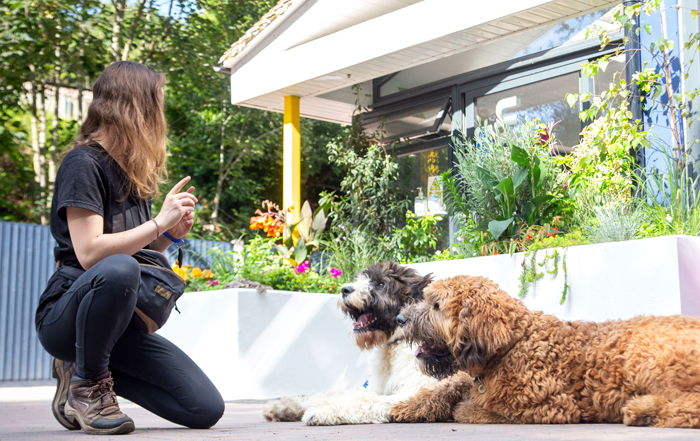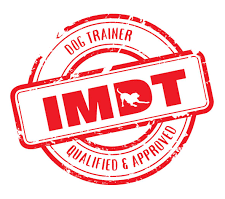This blog post explores the effect of residential dog training at Royvon and why the learning that they do with us translates into a change in behaviour when they leave Royvon and return home. We are commonly asked ‘How will you stop my dog running off?’, ‘How will you stop my dog barking?’, ‘How will you stop my dog being aggressive to other dogs or people?’ and other similar questions.
At the heart of all of these questions is a desire to stop a certain behaviour. In practice, the modern, positive dog training methods that we use at Royvon are about encouraging desired, alternative behaviour rather than focusing on stopping the undesired action directly. By giving a dog something else to do where they would normally react badly, they are drawn away from being fearful, being overstimulated by the environment or events around them. Instead we help to build the desire to do something else at this pivotal moment.
Focusing on play to change dog behaviour
More often than not, this alternative involves play. By making play exciting and irresistible, we create such a strong desire for the new ‘play’ thing that their other desires and reactions simply become less significant. The dog changes from being solely focused on the previous event or feeling and wants the new thing so much that they forget to care! We use this new drive to manipulate the situation that caused the original problem and change the repeated effect.
Looking at fear, a common issue for many of the dogs that we work with at Royvon, there is an added layer of complexity with the issue. As well as working with the dog to uncover the motivation to play, the dog trainer simultaneously has to help with desensitisation. This is not a simple process and our expert dog training team call on both their own training and experience to establish an environment where the dog is no longer taken over by their fear. This starts with working with the dog to learn at what distance away from the problem place or thing, the dog will still accept the enticement to play. Training continues at this distance until the trainer spots positive signals that the distance can be gradually reduced. In time this distance comes down to the point where the dog is still drawn to play even when very close to the original problem. Play may be backed up with food treats but we usually find that in these circumstances, the desire for food does not compare with the desire to play. When the dog is fully focused on play, they are able to forget about the original problem entirely.
So, in response to the above questions ‘How will you stop my dog…’ through residential dog training at Royvon, the answer is the intensely satisfying distraction of play. We increase the desire to play and practice this in as many contexts and environments as possible in and around our grounds.
Supporting continual dog training at home
When residential training is complete, we pass everything that has been learned on to the owner in a two hour session at pick-up. This session is spent transferring skills and establishing homework to work through in the following days. With the fear example given above, this will involve engaging the dog in play at home, an easy environment to maintain and build the desire to play. This is done to create a strong foundation without any pressure, without immediately testing the dog with a challenge that they find tough. The result of residential training is evident but to ensure it transfers into real-life scenarios, we work closely with owners to establish the same results reliably in different environments. Follow-up sessions one week and two weeks later continue to support dogs and owners through increasing challenges to the point where the dog no longer worries about the original problem and seeks to play instead.
To give an example, if the particular dog behaviour challenge that is faced is reactivity to strangers at the door, this method results in ‘counter conditioning’: when the door bell rings, the association isn’t one of fear but to know that the games are about to begin! Depending on the behaviour, our dog trainers may use a combination of Counter Conditioning and Desensitisation techniques for optimum results.
Our expert dog training team work with every dog as an individual, understanding what will work for them and working with the owner to meet the agreed goals. If the behaviour issue is that a dog is running off and ignoring recall, this may look like this:
- Learn what sort of play or games work to motivate each dog.
- Increase desire for that game.
- Teach the dog signals to understand when the game may start.
- Teach the dog how much fun this game is.
- Entice the dog with other things to build the connection that staying close is rewarding.
- Restrict the fun the dog can have without you (using a long line etc). The fun needs to come from you.
- Increase the level of difficulty using the training method, to the point where no matter what happens in the environment, the offer of the game or games entices your dog to want to return.
A kind and enriching approach to dog training without punishment
One of the key things that we never do is to punish dogs when they display undesirable behaviour. Old methods, still used by some trainers today, include the use of a device that hurts the dog when they behave in an incorrect way. If an owner is asking ‘How do you stop my dog running off?’, the answer with this method is simple: they are punished when they do so. We don’t align with this approach and believe that any loving dog parent wouldn’t choose to see their dog hurt. The intention of our positive reinforcement methods is to move away from the mindset of stopping a dog from doing one thing and concentrating on starting a desire to do another thing that we choose. We hope that this blog has helped to show the distinction. We would love to talk to you if you are facing challenges and are interested in the benefits of residential training.
Further information that you may find helpful:
https://royvon.co.uk/the-importance-of-play-for-your-dog/
https://royvon.co.uk/what-happens-after-your-dogs-residential-training-stay-with-royvon/





Leave A Comment